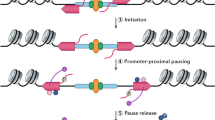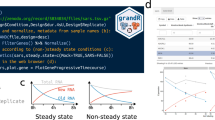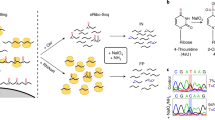Abstract
Cellular RNA levels are determined by the interplay of RNA production, processing and degradation. However, because most studies of RNA regulation do not distinguish the separate contributions of these processes, little is known about how they are temporally integrated. Here we combine metabolic labeling of RNA at high temporal resolution with advanced RNA quantification and computational modeling to estimate RNA transcription and degradation rates during the response of mouse dendritic cells to lipopolysaccharide. We find that changes in transcription rates determine the majority of temporal changes in RNA levels, but that changes in degradation rates are important for shaping sharp 'peaked' responses. We used sequencing of the newly transcribed RNA population to estimate temporally constant RNA processing and degradation rates genome wide. Degradation rates vary significantly between genes and contribute to the observed differences in the dynamic response. Certain transcripts, including those encoding cytokines and transcription factors, mature faster. Our study provides a quantitative approach to study the integrative process of RNA regulation.
This is a preview of subscription content, access via your institution
Access options
Subscribe to this journal
Receive 12 print issues and online access
$209.00 per year
only $17.42 per issue
Buy this article
- Purchase on Springer Link
- Instant access to full article PDF
Prices may be subject to local taxes which are calculated during checkout




Similar content being viewed by others
Accession codes
References
Kim, H.D., Shay, T., O'Shea, E.K. & Regev, A. Transcriptional regulatory circuits: predicting numbers from alphabets. Science 325, 429–432 (2009).
Wang, R.S., Zhang, X.S. & Chen, L. Inferring transcriptional interactions and regulator activities from experimental data. Mol. Cells 24, 307–315 (2007).
Raghavan, A. et al. Genome-wide analysis of mRNA decay in resting and activated primary human T lymphocytes. Nucleic Acids Res. 30, 5529–5538 (2002).
Shalem, O. et al. Transient transcriptional responses to stress are generated by opposing effects of mRNA production and degradation. Mol. Syst. Biol. 4, 223 (2008).
Amit, I. et al. A module of negative feedback regulators defines growth factor signaling. Nat. Genet. 39, 503–512 (2007).
Mellman, I. & Steinman, R.M. Dendritic cells: specialized and regulated antigen processing machines. Cell 106, 255–258 (2001).
Amit, I. et al. Unbiased reconstruction of a mammalian transcriptional network mediating pathogen responses. Science 326, 257–263 (2009).
Ernst, J., Vainas, O., Harbison, C.T., Simon, I. & Bar-Joseph, Z. Reconstructing dynamic regulatory maps. Mol. Syst. Biol. 3, 74 (2007).
Nachman, I., Regev, A. & Friedman, N. Inferring quantitative models of regulatory networks from expression data. Bioinformatics 20 Suppl 1, i248–i256 (2004).
Nilsson, R. et al. Transcriptional network dynamics in macrophage activation. Genomics 88, 133–142 (2006).
Ramsey, S.A. et al. Uncovering a macrophage transcriptional program by integrating evidence from motif scanning and expression dynamics. PLoS Comput. Biol. 4, e1000021 (2008).
Segal, E., Raveh-Sadka, T., Schroeder, M., Unnerstall, U. & Gaul, U. Predicting expression patterns from regulatory sequence in Drosophila segmentation. Nature 451, 535–540 (2008).
Barenco, M. et al. Dissection of a complex transcriptional response using genome-wide transcriptional modelling. Mol. Syst. Biol. 5, 327 (2009).
Elkon, R., Zlotorynski, E., Zeller, K.I. & Agami, R. Major role for mRNA stability in shaping the kinetics of gene induction. BMC Genomics 11, 259 (2010).
Garcia-Martinez, J., Aranda, A. & Perez-Ortin, J.E. Genomic run-on evaluates transcription rates for all yeast genes and identifies gene regulatory mechanisms. Mol. Cell 15, 303–313 (2004).
Cheadle, C. et al. Control of gene expression during T cell activation: alternate regulation of mRNA transcription and mRNA stability. BMC Genomics 6, 75 (2005).
Hao, S. & Baltimore, D. The stability of mRNA influences the temporal order of the induction of genes encoding inflammatory molecules. Nat. Immunol. 10, 281–288 (2009).
Core, L.J., Waterfall, J.J. & Lis, J.T. Nascent RNA sequencing reveals widespread pausing and divergent initiation at human promoters. Science 322, 1845–1848 (2008).
Wang, Y. et al. Precision and functional specificity in mRNA decay. Proc. Natl. Acad. Sci. USA 99, 5860–5865 (2002).
Pelechano, V. & Perez-Ortin, J.E. The transcriptional inhibitor thiolutin blocks mRNA degradation in yeast. Yeast 25, 85–92 (2008).
Amorim, M.J., Cotobal, C., Duncan, C. & Mata, J. Global coordination of transcriptional control and mRNA decay during cellular differentiation. Mol. Syst. Biol. 6, 380 (2010).
Cleary, M.D., Meiering, C.D., Jan, E., Guymon, R. & Boothroyd, J.C. Biosynthetic labeling of RNA with uracil phosphoribosyltransferase allows cell-specific microarray analysis of mRNA synthesis and decay. Nat. Biotechnol. 23, 232–237 (2005).
Dolken, L. et al. High-resolution gene expression profiling for simultaneous kinetic parameter analysis of RNA synthesis and decay. RNA 14, 1959–1972 (2008).
Friedel, C.C. & Dolken, L. Metabolic tagging and purification of nascent RNA: implications for transcriptomics. Mol. Biosyst. 5, 1271–1278 (2009).
Friedel, C.C., Dolken, L., Ruzsics, Z., Koszinowski, U.H. & Zimmer, R. Conserved principles of mammalian transcriptional regulation revealed by RNA half-life. Nucleic Acids Res. 37, e115 (2009).
Kenzelmann, M. et al. Microarray analysis of newly synthesized RNA in cells and animals. Proc. Natl. Acad. Sci. USA 104, 6164–6169 (2007).
Geiss, G.K. et al. Direct multiplexed measurement of gene expression with color-coded probe pairs. Nat. Biotechnol. 26, 317–325 (2008).
Levin, J.Z. et al. Comprehensive comparative analysis of strand-specific RNA sequencing methods. Nat. Methods 7, 709–715 (2010).
Chechik, G. & Koller, D. Timing of gene expression responses to environmental changes. J. Comput. Biol. 16, 279–290 (2009).
Chechik, G. et al. Activity motifs reveal principles of timing in transcriptional control of the yeast metabolic network. Nat. Biotechnol. 26, 1251–1259 (2008).
Pruitt, K.D., Tatusova, T. & Maglott, D.R. NCBI reference sequences (RefSeq): a curated non-redundant sequence database of genomes, transcripts and proteins. Nucleic Acids Res. 35, D61–D65 (2007).
Nam, K., Lee, G., Trambley, J., Devine, S.E. & Boeke, J.D. Severe growth defect in a Schizosaccharomyces pombe mutant defective in intron lariat degradation. Mol. Cell. Biol. 17, 809–818 (1997).
Kim, Y.J., Bjorklund, S., Li, Y., Sayre, M.H. & Kornberg, R.D. A multiprotein mediator of transcriptional activation and its interaction with the C-terminal repeat domain of RNA polymerase II. Cell 77, 599–608 (1994).
Kim, H.C., Kim, G.M., Yang, J.M. & Ki, J.W. Cloning, expression, and complementation test of the RNA lariat debranching enzyme cDNA from mouse. Mol. Cells 11, 198–203 (2001).
Clement, J.Q., Qian, L., Kaplinsky, N. & Wilkinson, M.F. The stability and fate of a spliced intron from vertebrate cells. RNA 5, 206–220 (1999).
Guttman, M. et al. Ab initio reconstruction of cell type-specific transcriptomes in mouse reveals the conserved multi-exonic structure of lincRNAs. Nat. Biotechnol. 28, 503–510 (2010).
Lai, W.S., Parker, J.S., Grissom, S.F., Stumpo, D.J. & Blackshear, P.J. Novel mRNA targets for tristetraprolin (TTP) identified by global analysis of stabilized transcripts in TTP-deficient fibroblasts. Mol. Cell. Biol. 26, 9196–9208 (2006).
Carballo, E., Lai, W.S. & Blackshear, P.J. Feedback inhibition of macrophage tumor necrosis factor-alpha production by tristetraprolin. Science 281, 1001–1005 (1998).
Lagarias, J.C., Reeds, J.A., Wright, M.H. & Wright, P.E. Convergence properties of the Nelder-Mead simplex method in low dimensions. SIAM J. Optimiz. 9, 112–147 (1998).
Hodges, J.L. & Lehmann, E.L. Basic Concepts of Probability and Statistics. 2nd edn. (Holden-Day, 1970).
Wilks, S.S. The large sample distribution of the likelihood ratio for testing composite hypotheses. Ann. Math. Stat. 9, 60–62 (1938).
Trapnell, C., Pachter, L. & Salzberg, S.L. TopHat: discovering splice junctions with RNA-Seq. Bioinformatics 25, 1105–1111 (2009).
Langmead, B., Trapnell, C., Pop, M. & Salzberg, S.L. Ultrafast and memory-efficient alignment of short DNA sequences to the human genome. Genome Biol. 10, R25 (2009).
Benson, D.A., Karsch-Mizrachi, I., Lipman, D.J., Ostell, J. & Wheeler, D.L. GenBank. Nucleic Acids Res. 36, D25–D30 (2008).
Rhead, B. et al. The UCSC Genome Browser database: update 2010. Nucleic Acids Res. 38, D613–D619 (2010).
Gardner, P.P. et al. Rfam: updates to the RNA families database. Nucleic Acids Res. 37, D136–D140 (2009).
Ye, J., McGinnis, S. & Madden, T.L. BLAST: improvements for better sequence analysis. Nucleic Acids Res. 34, W6 (2006).
Mortazavi, A., Williams, B.A., McCue, K., Schaeffer, L. & Wold, B. Mapping and quantifying mammalian transcriptomes by RNA-Seq. Nat. Methods 5, 621–628 (2008).
Vandesompele, J. et al. Accurate normalization of real-time quantitative RT-PCR data by geometric averaging of multiple internal control genes. Genome Biol 3, RESEARCH0034 (2002).
Subramanian, A. et al. Gene set enrichment analysis: a knowledge-based approach for interpreting genome-wide expression profiles. Proc. Natl. Acad. Sci. USA 102, 15545–15550 (2005).
Acknowledgements
We thank S. Schwartz for assistance in analyzing splicing signals, J. Bochicchio for project management and the Broad Sequencing Platform for all sequencing work. I.A. was supported by the Human Frontiers Science Program. Work was supported by the Howard Hughes Medical Institute, a National Institutes of Health PIONEER DP1-00003958-01 award, a Burroughs Wellcome Fund Career Award at the Scientific Interface and the Merkin Foundation for Stem Cell Research at the Broad Institute (A.R.) by a US-Israel Bi-national Science Foundation award (N.F. and A.R.) and the EU FP7 “MODEL-IN” consortium grant (N.F.).
Author information
Authors and Affiliations
Contributions
M.R., I.A. and A.R. conceived and designed the study. M.R. and I.A. conducted the experiments. M.R., N.F. and A.R. designed the computational methods. M.R. developed and implemented the computational methods. R.R. made the cell cultures. J.Z.L., X.A., L.F., A.G. and C.N. constructed and sequenced the cDNA libraries. N.H. contributed experimental methods and reagents. M.G. contributed computational methods for RNA-Seq analysis.
Corresponding authors
Ethics declarations
Competing interests
The authors declare no competing financial interests.
Supplementary information
Supplementary Text and Figures
Supplementary Methods, Supplementary Notes and Supplementary Figs. 1–24 (PDF 6164 kb)
Supplementary Table 1
The 254 genes in the 'signature' set. (XLS 28 kb)
Supplementary Table 2
nCounter measurements data. (XLS 375 kb)
Supplementary Table 3
Standard RNA-Seq sequencing libraries statistics. (XLS 14 kb)
Supplementary Table 4
4sU-Seq sequencing libraries statistics. (XLS 15 kb)
Supplementary Table 5
Functional enrichments in the 8 expression clusters. (XLS 51 kb)
Supplementary Table 6
Functional enrichments in 10 deciles with distinct (fixed) degradation rates and in the group of genes that reject the 'constant degradation' model. (XLS 173 kb)
Rights and permissions
About this article
Cite this article
Rabani, M., Levin, J., Fan, L. et al. Metabolic labeling of RNA uncovers principles of RNA production and degradation dynamics in mammalian cells. Nat Biotechnol 29, 436–442 (2011). https://doi.org/10.1038/nbt.1861
Received:
Accepted:
Published:
Issue Date:
DOI: https://doi.org/10.1038/nbt.1861
This article is cited by
-
Spatial imaging of glycoRNA in single cells with ARPLA
Nature Biotechnology (2024)
-
Well-TEMP-seq as a microwell-based strategy for massively parallel profiling of single-cell temporal RNA dynamics
Nature Communications (2023)
-
Estimating RNA dynamics using one time point for one sample in a single-pulse metabolic labeling experiment
BMC Bioinformatics (2022)
-
Control of immediate early gene expression by CPEB4-repressor complex-mediated mRNA degradation
Genome Biology (2022)
-
Live-seq enables temporal transcriptomic recording of single cells
Nature (2022)



